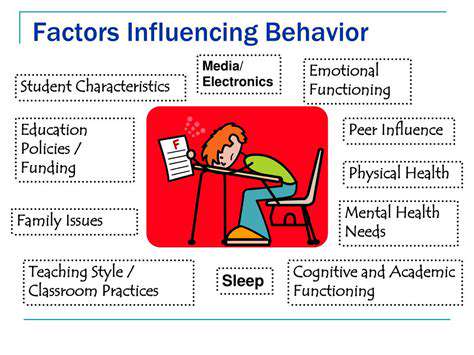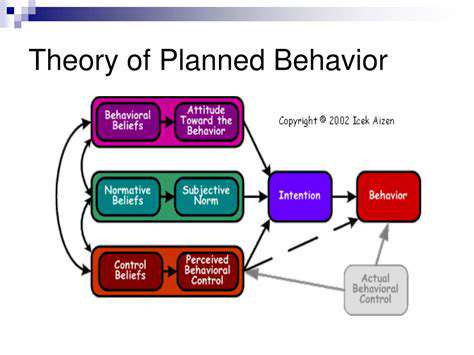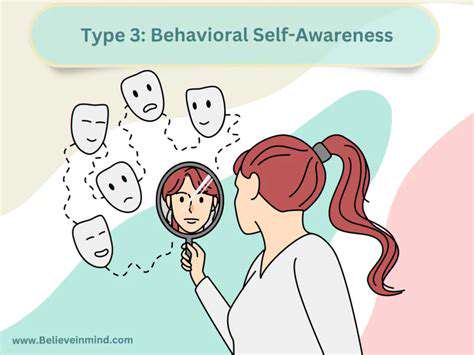Decoding Human Actions: A Comprehensive Guide to Behavioral Insights
The Importance of Understanding Human Behavior
The Role of Psychology in Understanding Behavior
Psychology plays a crucial role in decoding human actions, offering valuable insights into the motivations and thought processes behind individual behaviors. By studying various psychological theories and frameworks, we can explore how emotions, social influences, and cognitive biases affect decision-making.
Understanding psychological principles can also help in predicting how people are likely to respond in different situations. For example, theories like Maslow's hierarchy of needs can explain why individuals prioritize certain behaviors over others based on their current needs and desires.
Moreover, psychological research can assist in identifying abnormal behaviors and developing interventions to assist those in need. By recognizing patterns in human actions, psychologists can create strategies to promote healthier behaviors and improve overall well-being.
Social Influences on Behavior
Human behavior is significantly influenced by social contexts. Factors such as group dynamics, cultural norms, and peer pressure can shape how individuals act, often leading them to conform to societal expectations. Understanding these influences can unravel why individuals behave differently in isolated versus social settings.
For instance, the phenomenon of social loafing demonstrates how individuals may exert less effort when working in a group compared to working alone. This has implications for teamwork in various environments, including workplaces and academic institutions.
Additionally, cultural differences can lead to varied expressions of behavior. What is considered polite in one culture may be viewed as rude in another, highlighting the importance of cultural competence in studying human actions.
The Interplay of Emotion and Behavior
Emotions are a driving force behind many human actions. They influence our decisions, guide our interactions, and can even alter our physical responses to situations. Understanding the emotional underpinnings of behavior is essential for a comprehensive analysis of human actions.
Research in affective science reveals how emotions like happiness, fear, and anger can lead to specific actions that reflect these feelings. For instance, fear may trigger a fight-or-flight response, whereas happiness might promote prosocial behaviors and cooperation.
Furthermore, the ability to manage and regulate emotions can significantly impact behavioral outcomes. Emotional intelligence allows individuals to navigate social interactions effectively and respond appropriately to their own feelings and those of others.
Behavioral Change: Strategies and Applications
Recognizing that human behavior can change is vital in contexts ranging from personal development to public policy. Various strategies can facilitate this change, including motivational interviewing, cognitive-behavioral approaches, and habit formation techniques.
In personal development, understanding one's triggers and barriers can empower individuals to adopt healthier habits or break harmful ones. This involves setting realistic goals, monitoring progress, and adjusting strategies as necessary.
On a larger scale, policymakers can utilize behavioral insights to design interventions that promote positive actions within communities, such as encouraging recycling or increasing participation in health screenings. By employing behavioral science principles, these initiatives can significantly impact societal well-being.
The Factors Influencing Human Behavior

The Role of Environment in Shaping Behavior
The environment plays a crucial role in influencing human behavior. A person's surroundings can either promote positive actions or lead to negative outcomes. Urban areas, for example, often present different social cues compared to rural settings, affecting how individuals interact with one another.
Additionally, environmental factors such as natural light, noise levels, and spatial arrangements contribute to mood and behavior. These elements can create a conducive atmosphere for productivity or lead to stress and anxiety. Understanding the environmental impact is essential for fostering better behavioral outcomes.
The Impact of Social Influences on Behavior
Social interactions are one of the most significant determinants of human behavior. Our actions are often molded by cultural norms, peer pressure, and societal expectations, leading to either conformity or divergence from established behaviors.
Moreover, social influences can support personal growth and community well-being, or they can perpetuate harmful stereotypes and behaviors. Recognizing the power of social dynamics is essential for implementing effective changes in behavior. By understanding these influences, individuals and groups can work towards more positive interactions and outcomes.
Behavioral Theories and Models

Understanding Behavioral Theories
Behavioral theories provide frameworks for analyzing human actions and predicting behaviors based on various stimuli. These theories often take into account the psychological, social, and environmental factors that influence decision-making.
One of the foundational theories is B.F. Skinner's operant conditioning, which explains how behaviors are shaped by rewards and punishments. This model helps us understand how reinforcement can increase the likelihood of certain behaviors, making it essential in fields like education and behavior modification.
Models of Human Behavior
In addition to behavioral theories, models such as the Social Learning Theory emphasize the importance of observational learning. This model suggests that individuals learn and mimic behaviors by watching others, highlighting the role of social contexts in shaping our actions.
Another significant model is the Theory of Planned Behavior, which posits that behavioral intention is influenced by attitudes, subjective norms, and perceived behavioral control. Understanding these models is crucial for developing strategies aimed at changing unwanted behaviors and promoting positive ones.
Applications of Behavioral Insights
Understanding Behavioral Economics
Behavioral economics combines insights from psychology and economics to explain why people make irrational decisions. Traditional economics assumes that individuals act rationally to maximize utility, but real-life choices often deviate from this ideal. Understanding these deviations can help predict and influence behaviors in various contexts.
For instance, factors like loss aversion, where people prefer avoiding losses over acquiring equivalent gains, significantly influence decision-making. This concept explains why individuals may hold onto losing investments longer than is financially prudent.
Moreover, the framing effect demonstrates how different presentations of the same information can lead to different decisions. By carefully framing options, businesses and policymakers can encourage more beneficial choices for individuals and society.
By studying behavioral economics, we gain valuable insights into consumer behavior, financial decision-making, and even public health initiatives. It highlights the need for comprehensive strategies that account for human psychology rather than solely relying on rational choice models.
Overall, exploring behavioral economics fosters a deeper understanding of human actions, aiding in the development of effective interventions and policies across various sectors.
Applications in Marketing and Consumer Behavior
Behavioral insights are instrumental in shaping marketing strategies and enhancing consumer engagement. By understanding the psychological triggers that influence purchasing decisions, marketers can create campaigns that resonate more deeply with target audiences.
Tactics such as scarcity and urgency leverage emotional responses; consumers are often more inclined to buy when they believe an item is in limited supply or that an offer is temporary. Marketers frequently employ phrases like "limited time offer" to compel faster decision-making.
Another technique is the use of social proof, where individuals are influenced by the actions of others. Testimonials, reviews, and influencer partnerships can significantly sway potential buyers by showcasing that others have endorsed a product or service.
Additionally, personalization in marketing has become paramount. By utilizing data analytics, businesses can tailor messages and recommendations to individual preferences, which enhances the likelihood of conversion. Personal touch reinforces consumer loyalty and satisfaction.
Overall, the application of behavioral insights in marketing not only drives sales but also fosters better relationships between brands and consumers, paving the way for long-term success.
Influencing Public Policy through Behavioral Insights
Governments and organizations are increasingly recognizing the value of behavioral insights in crafting effective public policy. By understanding how citizens think and behave, policymakers can design initiatives that promote positive societal outcomes.
Nudging is a popular concept in behavioral policy, where subtle changes in the environment or presentation of choices can lead to better decisions without restricting options. For example, automatic enrollment in retirement savings plans encourages participation without mandating it.
Public health campaigns also benefit greatly from behavioral insights. Strategies that utilize social norms—such as showing a high percentage of people getting vaccinated—can encourage others to follow suit, thus improving public health outcomes significantly.
Furthermore, addressing issues like climate change requires behavioral strategies that motivate people to adopt sustainable practices. Campaigns that highlight community involvement and collective action can shift behaviors towards more environmentally-friendly choices.
By integrating behavioral insights into policy-making, governments have the potential to enhance the effectiveness of their programs, creating a more informed and engaged citizenry.
The Role of Technology in Behavioral Analysis
Advancements in technology are revolutionizing the study of human behavior, facilitating sophisticated analyses that were previously unimaginable. Big data, machine learning, and artificial intelligence are now integral in identifying patterns and trends in human actions.
Collecting vast amounts of data from various sources allows researchers to develop predictive models that can analyze consumer behavior, health choices, and even social interactions. This data-driven approach enables the identification of effective interventions tailored to specific populations.
Moreover, technology has enabled real-time feedback mechanisms, allowing individuals to track their behaviors and make adjustments instantly. For instance, fitness apps that monitor physical activity or spending trackers that highlight financial habits empower users to take greater control over their lives.
Social media platforms act as a rich source of behavioral data, providing insights into public sentiment and behavior on a large scale. Understanding how trends spread and why certain behaviors gain traction can help businesses and policymakers navigate modern societal challenges.
Ultimately, technology acts as a catalyst for deeper behavioral insights, fostering innovation and practical applications at individual, organizational, and societal levels.
Developing Behavioral Awareness

Understanding the Basics of Behavioral Awareness
Behavioral awareness refers to the conscious recognition of one's own behaviors and those of others. This self-awareness is crucial for personal and professional growth. By recognizing our actions, we can better understand their impact on those around us.
Additionally, developing behavioral awareness can enhance communication skills. When we are aware of how our behaviors affect conversations, it allows for more meaningful interactions. Understanding these dynamics can lead to improved relationships.
Finally, behavioral awareness is linked to emotional intelligence. Individuals who are attuned to their actions often exhibit greater empathy. This empathy can foster deeper connections in both personal and workplace environments.
Strategies for Enhancing Behavioral Awareness
One effective method for enhancing behavioral awareness is through mindfulness practices. Mindfulness encourages individuals to observe their thoughts and actions without judgment. This practice promotes a clearer understanding of one's behaviors over time.
Another strategy is to solicit feedback from others. Asking for constructive criticism can provide insights into our actions that we may overlook. This external perspective is invaluable for personal development.
Finally, maintaining a reflective journal can be beneficial. Writing about daily experiences and emotions allows individuals to track their behaviors and identify patterns. This tool can highlight areas for improvement and growth.
The Role of Environment in Behavioral Awareness
Our environment significantly influences our behaviors and awareness. For instance, a supportive and open space can encourage candid reflections. This leads to a greater understanding of our actions within that context.
Conversely, a negative or competitive environment can stifle honesty about behavior. People may become defensive or disengaged, hindering their ability to learn from experiences. Thus, creating a positive environment is essential for fostering behavioral awareness.
Additionally, cultural contexts play a critical role. Different cultures have varying expectations and norms regarding behavior. Recognizing these nuances can enhance cross-cultural understanding and improve interpersonal dynamics.
Applications of Behavioral Awareness in Daily Life
Developing behavioral awareness can significantly impact decision-making. Individuals who understand their motivations are better equipped to make informed choices. This leads to actions that align more closely with their values and goals.
In the workplace, behavioral awareness contributes to effective leadership. Leaders who are aware of their behaviors can inspire their teams and foster a positive work culture. This awareness also helps in conflict resolution by understanding different perspectives.
Lastly, behavioral awareness plays a vital role in personal relationships. Recognizing harmful patterns can lead to healthier interactions. When both partners are mindful of their behaviors, it promotes a harmonious relationship where both individuals feel valued and understood.
- How to Identify Your Dog's Coat Length for Optimal Grooming
- Sustainable Gardening Practices for Beginners
- Essential Grooming Schedule for Maintaining a Healthy Coat
- Dog grooming mistakes every owner should avoid
- Embracing Mindfulness for a Balanced and Fulfilling Life
- Promoting Environmental Sustainability Through Community Initiatives
- Storm Risks for Dogs: What Pet Owners Need to Know
- How Seasonal Changes Impact Your Dog's Health and Behavior
- Essential fall care tips for your dog’s health
- Boosting Employee Engagement Through Meaningful Connections
- The Unique Temperament of Every Dog: A Guide for Dog Owners
- Nail Trimming: A Crucial Element for Pet Health and Hygiene